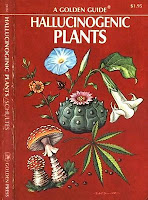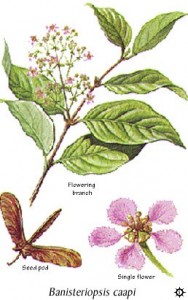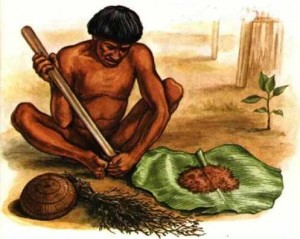 |
If you are as old as I am, you remember growing up with the Golden Guide books — sturdy, profusely illustrated, pocket-sized guides to such topics as flowers, planets, spiders, birds, stars, painting, pond life, photography, and rocks and minerals, intended for a young audience. They were perfect for taking along on field trips for identification purposes. The series began in 1949 with Birds and continued — remarkably — until Endangered Animals in 1995. There is, of course, a collector’s website with details about every Golden Guide ever published.
In 1976, the series published A Golden Guide To Hallucinogenic Plants, written by famed Harvard botanist and Amazon explorer — and, some say, model for Indiana Jones — Richard Evans Schultes, with illustrations by Elmer W. Smith. Schultes spent decades in the Amazon, collected over 30,000 herbarium specimens, including 300 species new to science, and cataloged 2,000 medicinal plants. More than 120 species bear his name, as does a 2.2 million-acre tract of protected rain forest in Colombia, Sector Schultes, which the government there set aside in 1986. He studied both peyote and ayahuasca, and he was the first botanist to identify the traditional Mexican hallucinogens teonanácatl and ololiuqui. There was no one in the country better qualified to write the book.
 |
The book has become quite rare. A quick look around the online used bookstores shows copies of the original hardcover edition for sale at prices as high as $858.00. Some maintain that this scarcity is the result of deliberate suppression — that the book was promptly recalled, pulled from the shelves, discontinued by the publisher. I have seen no evidence of such censorship; in fact, the book apparently went through four printings before being allowed to go out of print.
The book itself is wonderful, with beautiful botanical illustrations, a lot of cultural detail, and ethnographic paintings with the sort of old-fashioned charm that somehow reminds me of the dioramas of exotic peoples I used to love as a boy at the American Museum of Natural History. The writing is straightforward and is, for its intended audience, at a high level of sophistication. I suppose I should be retroactively offended by references to “primitive societies” and “early man,” but somehow I just can’t work up much indignation.
 |
If you want to take a look, a copy has been lovingly scanned, transcribed, and posted by the invaluable Vaults of Erowid. Another copy is here. We should credit David Pescovitz at Boing-Boing for first bringing this gem to the attention of the online community.
Here is the description from the back cover of the book:
And, in the introduction, Schultes writes:What are hallucinogenic plants? How do they affect mind and body? Who uses them — and why? This unique Golden Guide surveys the role of psychoactive plants in primitive and civilized societies from early times to the present. The first nontechnical guide to both the cultural significance and physiological effects of hallucinogens, hallucinogenic plants will fascinate general readers and students of anthropology and history as well as botanists and other specialists. All of the wild and cultivated species considered are illustrated in brilliant full color.
Hallucinogenic plants have been used by man for thousands of years, probably since he began gathering plants for food. The hallucinogens have continued to receive the attention of civilized man through the ages. Recently, we have gone through a period during which sophisticated Western society has “discovered” hallucinogens, and some sectors of that society have taken up, for one reason or another, the use of such plants. This trend may be destined to continue.
It is, therefore, important for us to learn as much as we can about hallucinogenic plants. A great body of scientific literature has been published about their uses and their effects, but the information is often locked away in technical journals. The interested layman has a right to sound information on which to base his opinions. This book has been written partly to provide that kind of information.
No matter whether we believe that men’s intake of hallucinogens in primitive or sophisticated societies constitutes use, misuse, or abuse, hallucinogenic plants have undeniably played an extensive role in human culture and probably shall continue to do so. It follows that a clear understanding of these physically and socially potent agents should be a part of man’s general education.

- Previous Post: Jaguar on Ayahuasca
- Next Post: Good Blog: Legitimos Guerreritos
- More Articles Related to: Books and Art, Sacred Plants, The Medicine Path



Congratulations on the 200th post!
This blog is the perfect excuse (in my mind), to not do my school work and read something intersting and fun.
I owe you a brew!
Hello. There are 14 copies currently on Amazon from $29. http://www.amazon.com/Hallucinogenic-plants-Richard-Evans-Schultes/dp/0307243621/ref=sr_11_1?ie=UTF8&qid=1238946584&sr=11-1
Cheers
Thank you for the information.
I am looking for the name of a plant root found in the high desert of California that causes severe hallucinations? Can anyone help?
You are probably thinking of Datura stramonium, also called jimson weed and several other names. This is a very powerful and sacred plant, related to the toé (Brugmanisa spp.) of the Upper Amazonian shamans, and is rich in tropane alkaloids, especially scopolamine. I have written about scopolamine-containing sacred plants and their effects here and here.
Ingesting Datura plants carries a high risk of a very unpleasant experience. People who have ingested scopolamine have visual, auditory, and tactile hallucinations that can be very paranoid and frightening, and, unsupervised, they can do harm to themselves and others. These are very powerful plants, and they should be ingested — if at all — only with expert guidance by someone who knows them well.